 This article originally appeared on Medium. When Governor Gavin Newsom took office in January 2019, he saw the untapped potential within California’s private sector. Home to Silicon Valley and Hollywood, California is one of the biggest economic and innovation engines in the world. Governor Newsom, knowing that government alone can’t solve all our problems, pulled together California’s greatest minds to address some of our most pressing issues. In doing so, the state has led 44 public-private partnerships — totaling more than $4 billion in just three years in corporate and philanthropic support — to help fill the critical gaps in providing essential services for Californians throughout the Golden State. California’s successful social innovation program shows that government and philanthropy do not have to operate in isolation — when Californians come together to show love for Californians, we become stronger than ever. And by working with the private sector on these issues, the state is not only tapping into some of the world’s best talent, but also saving taxpayer dollars. For the past two years I’ve been working as Governor Newsom’s Senior Advisor for Social Innovation, helping bridge the philanthropic arms of our state’s most innovative companies and the laser-focused nonprofits and initiatives tackling our biggest challenges. In December we launched our second Social Innovation Impact report, detailing the tangible results of our spirited collaboration and innovation. We are so grateful to the California organizations — in the tech world and beyond — who stepped up and stepped in over the last two years and invested billions into our vital social programs and nonprofits. Through this pandemic, it has been so inspiring to see hundreds of companies, foundations and nonprofits raise their hand and ask, “How can we help?” During the transition to online learning in the early stages of the pandemic, one in five California students did not have access to laptops and other devices needed to participate in distance learning. We partnered with companies like T-Mobile, Google and HP to get hot spots and laptops to our students, particularly those in rural California. And, Intel lent its supply chain expertise to get us access to these devices when they were in short supply globally. Thanks to these partnerships, today 98 percent of California’s students now have access to digital learning devices. And we couldn’t have done it without the tremendous support of so many companies around the state who stepped up when California students needed it most. Our Homekey initiative is the state’s $3.6 billion program to purchase hotels, motels, vacant office buildings, tiny homes and other adaptive reuse properties and convert them into housing for thousands of people living on the streets. Across the state, nonprofits and homebuilders have leveraged Homekey dollars to bring affordable housing onto the market quickly. Homekey is an example of innovation at its best. With the private sector, we created over 6,000 affordable units last year alone -- in record time and at a fraction of the cost. Homekey has been the fastest, largest, most cost-effective addition of permanent housing in California history, successfully re-engineering the strategy to create more housing for people experiencing homelessness. One of my favorite partnerships was with Lennar Homes, who purchased 86 tiny homes near the Westwood Veterans Affairs building to shelter homeless veterans who had been living in tents outside the facility. California’s strength lies in its diversity. When hundreds of Afghan families started arriving in California, we knew we had to find ways to support them. Over the past several months, we’ve partnered with resettlement agencies and Afghan-led community-based organizations, like The Afghan Coalition, to make sure that they have the help and resources needed to support our new neighbors. We’ve also partnered with San Francisco-based Airbnb, which is leading an incredible initiative to provide temporary housing for newly arriving Afghan families in California. So far, this effort has housed 1000 individuals through Airbnb hosts. Looking forward, we’re excited to expand our public-private partnerships and further leverage funding in the newly unveiled California Blueprint. We hope you will join us, and that these results will inspire other states, and even our federal partners, to emulate our approach. While we have been tested in the last few years — by fires, by disease, even at times, by each other — this spirit will keep us moving toward a California For All built on love that we aspire to create.
0 Comments
Three areas where philanthropic funders can partner with government on infrastructure investments to advance equity in the United States.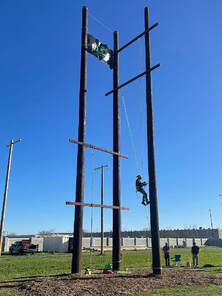 This article originally appeared in Stanford Social Innovation Review. Over the past several months I have received calls from dozens of philanthropic leaders eager to help ensure that the trillions of dollars flowing to US communities through the federal Infrastructure and Jobs Investment Act reach the country’s most vulnerable communities. But they often don’t know where their dollars will make the most impact. While building things like roads and bridges or providing clean water is traditionally the work of government, public-philanthropic partnership provides a framework to ensure that local, state, and federal governments work closely with community-based organizations and philanthropic entities so that government funding actually serves people’s needs and lays the groundwork for lasting, equitable change. The good news is that we have strong models for governing in partnership with the philanthropic sector to support local communities and scale impact at all levels of government. In cities across the country, Bloomberg Associates’ Collaborative Cities initiative, for example, is seeding partnerships between the public, private, and nonprofit sectors to help cities creatively tackle social issues. The initiative helps different partners marshal resources, coordinate responses, and leverage the unique assets each brings to the table. In Michigan, the Office of the Foundation Liaison has an 18-year track record of forging partnerships between state government and the philanthropic sector to encourage programs or policy reforms that would improve the lives of residents. And in California, Governor Newsom has led 42 public-philanthropic partnerships leveraging more than $4 billion in private funding to advance policy priorities like addressing homelessness and fighting the COVID-19 pandemic. Based on the dozens of public-private partnerships we’ve led in California, we see three areas where philanthropic funders would do well to invest now: 1. Civic Infrastructure Through Community Capacity Building While the majority of the focus on the infrastructure bill has been on roads, bridges, and broadband, one major opportunity that often gets overlooked is the chance to invest in civic infrastructure. Philanthropy is well-poised to support the capacity building of local organizations so that they can build the strength and voice they need to effectively represent community interests, not just now but for the long run. This kind of cross-sector collaboration was a force behind our efforts to count all Californians in the 2020 census. The state worked with foundations to invest a combined $130 million in supporting community-based organizations (CBOs) so that they could reach people of color, as well as disabled, low-income, and other traditionally hard-to-count communities. We took worked with CBOs to do door knocking, calls, and outreach events, targeting zip codes where people were at-risk of not being counted. As the census wrapped up, COVID-19 vaccines were just getting approved, so we doubled down on our partnerships with these organizations to reach those same less-resourced communities. As of the end of this year, our partnerships with Public Health Institute’s Together Toward Health Initiative, Sierra Health Foundation’s Vaccine Equity Campaign, and California Community Foundation have channeled more than $100 million to more than 700 CBO partners, reaching people in all of California’s 58 counties to educate them about the importance of getting vaccinated and provide support with vaccine appointments. Now is the time to build on networks of local partners to ensure that infrastructure spending is distributed equitably. For example, our office is developing a partnership between the California Natural Resources Agency Water Foundation and the Water Foundation and Water Funders Initiative to build community power and capacity to benefit from public funding, support water leaders who can represent community priorities, and support systemic solutions by aligning relief efforts with long-term strategies such as infrastructure investments. In the coming months and years, state and local agencies across the United States will be distributing trillions of dollars that community-based organizations often can’t access, because they are too small to apply for complicated public funding grants. Philanthropic investments can help ensure that these organizations don’t end up on the sidelines by supporting their capacity to help influence how funding is distributed. 2. Technical Assistance State and local agencies now tasked with implementing major expansions of programs like the child tax credit, broadband, and public transit projects will need to bring on more staff to distribute infrastructure funding within the bill’s time constraints. And state employees aren’t always in the best position to get out into communities to ensure that they are aware of these programs and how to participate. Philanthropic partnership can help provide the technical assistance agencies need to both ramp up their programs and to ensure that communities are part of the program design from the start. One example is a partnership we developed in California to support technical assistance for workforce development organizations. The High Road Training Partnerships (HRTP) program, managed by the state Workforce Development Board (CWDB), supports high-quality jobs by funding collaboration between private employers, local community-based organizations, and labor. HRTP collaborations develop high-quality opportunities in targeted industries, get workers jobs, and enable them to develop stability in those jobs. Partnerships like these are critical in the context of infrastructure, where for every billion spent, an estimated 20,000 jobs are created. This year, the state invested $100 million to expand the HRTP program, and CWDB has partnered with Jobs for the Future—a national nonprofit that drives change in workforce and education systems—to create technical assistance microgrants that cover pre-application costs and help CBOs and other small organizations apply for the funding. Additionally, the Community Economic Resilience Fund, a $600 million state fund to support regional economic development planning in 13 regions in California, is a huge opportunity to build jobs for the future and develop inclusive, sustainable local economies. Philanthropic partners led by the James Irvine Foundation have come together to support mapping of existing community efforts and facilitation by California Forward, a statewide economic development organization, and PolicyLink, a national institute to advance racial and economic equity, to ensure that communities have the resources to put inclusion and racial equity at the center of these plans. By working in partnership with the state to support these types of technical assistance, philanthropy can help give vulnerable communities greater agency in determining how to spend the influx of public dollars, having potential impact for generations to come. 3. Research and Evaluation Philanthropic organizations have a long tradition of supporting research and evaluation in partnership with government, but with so much public funding at play, this is a moment to scale innovative policies and programs like never before. But making these programs sustainable requires that we develop strong data and evaluation practices to determine whether they are actually having an impact. Philanthropic partners are well poised to support evaluation efforts which could be used to improve these initiatives and advance policy advocacy for future programming. For example, during the early days of the pandemic, we launched an initiative called Project Roomkey to house 50,000 unsheltered people in hotels and motels across the state rather than in congregate shelters. The program is potentially game-changing for our ability to house Californians in the long run, but to prove its full impact, California Health Care Foundation and Hilton Foundation are working together with the California Health and Human Services Agency to evaluate it, with a specific focus on the health impacts of providing housing and services. Philanthropic leaders should examine opportunities to partner with state and local agencies to ensure that research and evaluation are built into infrastructure spending from the start, as opposed to being an afterthought. We must not let this historic moment go to waste. With trillions of dollars flooding state and local agencies over the next several years, philanthropic partners can and should find ways to ensure that those dollars are truly reaching the communities that need it most. If that happens, we will be able to look back and know that this was a moment when America reversed the tide of inequity in our society. 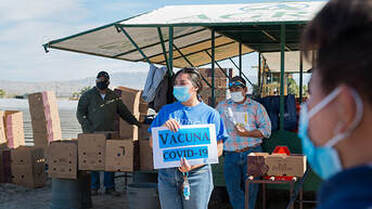 This article by Kathleen Kelly Janus and Marciela Rodriguez originally appeared in the Press Enterprise. In March of this year, President Biden told Americans that vaccinations would allow us to celebrate July 4 with neighborhood cookouts. Four months later, California became one of 18 states to reach the White House milestone of vaccinating 70% of our eligible population. While reaching this goal made Independence Day celebrations possible, it is the strong community partnerships that have been built by vaccinating over 20 million Californians that promise to have lasting effects long after this pandemic is over. Before the goal was met, the community infrastructure created by those of us in state operations was essential for conducting one of the most comprehensive census count efforts in history: Census 2020. In the middle of it, we had to adjust when COVID-19 struck so we could deliver nearly 50 million COVID vaccinations. Both operations provided critical lessons that will help prepare us for the next stage of economic recovery. At the heart of these efforts sits a robust community organizing model. In California, we’ve seen first-hand that community engagement isn’t just about helping; it’s about hearing from people first, then responding to their needs. California’s 2020 Census and vaccination efforts center on a data-driven approach that prioritizes hard-to-count communities. With a state as big and diverse as California, partnerships outside of government also are necessary. During the lead up to the census, hundreds of local CBOs were engaged. The $130 million public-private partnership invested in promotoras—health workers in the Latino community—and other community organizers. These trusted messengers not only mitigated the fear families were facing from harsh anti-immigration rhetoric and policies, they also lifted up the voices of those who have historically been marginalized. Census details included meetings with nonprofit leaders, held regularly to share best practices and address barriers that existed across different communities. This coordination became critical when the pandemic hit in early 2020, forcing the entire outreach operation to shift away from planned in-person events and activities. Pivoting when COVID-19 hit was challenging but successful, thanks to the strong foundation of trusted relationships and community infrastructure that had been established. Once vaccines were proven safe and effective for distribution, California built on the Census community outreach infrastructure, establishing a vaccine equity framework and an all-hands-on-deck outreach effort to vaccinate those who were disproportionately impacted by the pandemic. We tapped many of our top census partners throughout California and funded them to do COVID-19 outreach and vaccine appointment assistance. We worked with philanthropic partners like The Center at Sierra Health Foundation, the California Community Foundation and the Public Health Institute Together Toward Health Initiative, and additional CBOs. Their collaborative work often led to additional and desperately needed funding of community-based pop-up vaccine clinics, staffing and transportation. These efforts are playing out in communities throughout California and will be critical to reaching our vaccine equity goals. Take the work of Leadership Counsel for Justice and Accountability (LCJA) in Lanare, Calif., to connect rural farmworkers with vaccines. Over the past few months LCJA helped provide over 1,000 vaccines to communities in partnership with local public health leaders with door-to-door canvassing, phone calls, and bilingual registration to reduce barriers to participation. In the Inland Empire, El Sol Neighborhood Educational Center delivered nearly 6,000 vaccinations and 7,000 COVID-19 personal care kits to increase protection in California’s most vulnerable communities. El Sol was recently recognized by President Biden at a White House celebration and honored as a Nonprofit of the Year by the California Association of Nonprofits. We don’t claim to have everything figured out when it comes to community engagement, and we continuously seek to do better. But there is no doubt that we know how to leverage the strengths of the public and private sectors to strengthen our efforts. As we get closer to ending this pandemic, we will continue listening to people from our communities as they talk about what they need for jobs, housing, health care and other inequities we face, and partner with the many essential community-based organizations in California to meet those needs. Four ways philanthropy can effectively partner with governments to support equitable vaccination distribution and ensure that more individuals are vaccinated against COVID-19. 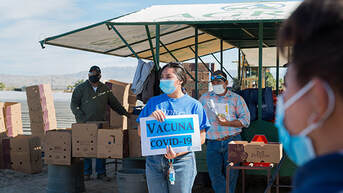 This article originally appeared in Stanford Social Innovation Review. After nearly a year of living through the biggest public health crisis in generations—with 100 million people infected, 2 million people dead, and almost everyone’s lives disrupted—the world is desperate to see widespread vaccination against COVID-19. But the excitement of the Pfizer and Moderna vaccine approvals in December 2020 has since dampened after a rocky rollout to get those vaccines into people’s arms. It’s not enough to have a vaccine; it must be distributed effectively and equitably. The good news is that vaccine distribution is picking up speed in many places. In the United States, President Biden has promised to invest significant federal dollars to provide states with the resources they need to vaccinate their residents. But this support will take time to secure and distribute while the need remains urgent. One barrier is significant rates of vaccine hesitancy rates, driven in part by a history of medical exploitation and mistreatment toward people of color in the United States. A recent study showed that just 14 percent of Black Americans and 34 percent of Latinx Americans trust that a COVID-19 vaccine will be safe. Moments like this call for public-private partnership. In my role managing public-private partnerships for the Office of the Governor in California, I’ve seen throughout the COVID-19 pandemic that working together and leveraging the strengths of both sectors has created significantly more impact than working alone. As we move into this new phase of attempting a historic mass-vaccination campaign in the United States, many in the philanthropic sector are eager to support the process in ways big and small. But given the unpredictable nature of the vaccination roll out, foundations and donors aren’t always sure how to leverage their investments most effectively. While we still have much to learn as the process continues, the following are four ways philanthropy can effectively partner with governments now to support equitable vaccination distribution and ensure that more individuals are vaccinated against COVID-19: 1. Invest in Trusted Messengers Experts say that as much as 90 percent of the population must achieve immunity to eliminate COVID-19, and yet public confidence in the vaccine—particularly among communities of color—falls far short of that. About a quarter of the public feels hesitant about the COVID-19 vaccine, meaning they say they probably or definitely will not get it. This is much higher among Black adults, with 35 percent saying they definitely will not get vaccinated. We know that trusted messengers—well-respected community leaders who live and work in ethnic and racial minority communities disproportionately affected by the virus—are important to reaching vaccine-hesitant communities. However, community-based organizations like local health clinics or promotoras that often play that role aren’t always large enough to apply for state or local funding. Philanthropy can help fill that gap. An unlikely example that provides a great playbook for what works is something unrelated to public health: the US Census. The country recently invested hundreds of millions of dollars building the capacity of a network of trusted messengers, to convince hard-to-reach populations to fill out the 2020 census. In California alone, state government and philanthropic partners worked together to fund hundreds of organizations that have close connections to groups like farmworkers, people with disabilities, and tribal communities—many of the same underrepresented communities that need information and support on vaccination. One public-private partnership building on this model is Together Toward Health—a collaboration between the State of California, Public Health Institute, and a group of philanthropic funders led by The California Endowment. This $28 million fund is dedicated to funding organizations on the ground to do community education and outreach on COVID-19, including information on why and how to get vaccinated. The philanthropic funding is coordinated with a $30 million investment from the state to fund outreach and education, including through many of the same organizations that supported the state’s census efforts. Investing in local grassroots organizations to support vaccine education isn’t just important to the success of vaccination efforts. By focusing on organizations led by people of color and other underrepresented leaders, who are well-positioned to reach vulnerable communities, we can also create more equity. Investment in these groups will help seed a new generation of leadership in the nonprofit sector and create an infrastructure for community-engagement that will last long after the COVID crisis. 2. Support Innovative Delivery of Vaccines On the distribution of the vaccines, the state and the federal government will be playing the primary role. The Biden Administration has announced that the federal government will be setting up 100 vaccine mega-sites throughout the country, and states have been launching their own mass vaccination programs in sports arenas and other large venues. Hospitals, local health clinics, and health-care providers are acting as vaccine administrators, and community-based testing sites are converting some of their appointments to vaccine appointments. But even these efforts aren’t enough; we need a wide range of innovative approaches. For example, one mobile vaccination site in Coachella Valley, California—led by the immigrant-support organization TODEC and several local agencies, and in partnership with Riverside County and Together Toward Health—vaccinated 250 agricultural workers in a single day. These workers received their vaccines during their shifts to avoid lost wages, and the site will return in three weeks to provide the second dose. Philanthropic funding supported staffing from eight local community-based organizations that helped lead the effort. Similar efforts are also taking a holistic approach to worker well-being by offering food distribution, COVID testing and education, as well as worker rights and tenant protection education. We can also take learnings from distribution of the flu vaccine, where employers around the United States regularly provide easy ways for their employees to get vaccinated. We have also seen innovative pilots with schools. For example, an effective school-located influenza vaccination program called Shoo the Flu—fueled by a partnership between a county health department, a school district, and philanthropy—provided more than 55,000 vaccinations for preschools and elementary students and staff in 95 Northern Californian schools between 2014 and 2019. The impact of this city-wide program was significant, resulting in greater vaccination coverage, fewer school absences, and lower community-wide hospitalizations. As vaccine supply becomes more available, philanthropy can support innovative pilots in partnership with schools, community health centers, collaboratives, and even companies (Uber, for example, has offered free and discounted rides to get people to vaccine sites). These efforts will help meet harder-to-reach communities where they are. 3. Support Job Training Programs for Community Health Workers Philanthropy can also invest in training public health workers for immediate roles in contact tracing, community outreach, and education, as well as for longer-term careers in public health and health care. The United States has historically underinvested in its public health infrastructure, leaving an insufficient number of health care workers to address the pandemic. This, coupled with the fact that nearly 11 million Americans are currently unemployed, presents an ideal opportunity to both address COVID tracking and vaccination, and get people back to work. The health care provider Kaiser Permanente is doing this through its partnership with the State of California. Through a grant to the Public Health Institute, it’s funding the hiring and training of 500 full-time workers—individuals who are linguistically and culturally competent, and who can support contact tracing work for the communities they serve. One example is John Franco. In 2020, Franco lost his job and then contracted COVID-19. A call from a contact tracer alerted him that he had been exposed to the disease, which stopped him from going to visit his mother the next day and spreading the virus to her. This experience inspired him to apply for the Kaiser Permanente program to become a contact tracer himself. He not only has served as a bilingual contact tracer for his community, but is now taking public health classes on the side and planning for a career in the field. Similar efforts are sprouting up in other areas of the country too. In Chicago, for example, the Vaccine Corps Partnership is hiring community health workers to support the equitable distribution of vaccines, and Futuro Health is supporting online training for people interested in health-care careers. Innovations in workforce development to address COVID-19 and the economic crisis can move people from unemployment and despair to hope and new careers. 4. Invest in Coordination Finally, we know that coordination at the national, state, and local levels will help bring more people to the table, and will ensure that we’re all leveraging each other’s strengths in this historic effort to vaccinate Americans. One example is the COVID Collaborative—funded by the Skoll Foundation in partnership with the NAACP, UnidosUS, and Langer Research—which recently released results of a survey on vaccine hesitancy in Black and Latinx communities. Another is the Rockefeller Foundation’s State and Territory Alliance for Testing, which fosters collaboration among governors on testing and is helping develop best practices related to vaccines. At the local level, the Community Foundation in Monterey County is funding a weekly, facilitated conversation to ensure that local leaders are advancing a multi-sector, coordinated action plan to support public health and equity. The reality is that we’re learning as we go when it comes to vaccine distribution. But while we still don’t fully know how our vaccination efforts will take shape, which interventions will reach the most people, or how we can be most efficient while still maintaining a focus on equity, philanthropy can act now to help government be more innovative in the process. This is the time to work together to get more vaccines in people’s arms and help bring this dark period of public health crisis to a close. 12/3/2020 0 Comments Governing in PartnershipHow governments can partner with philanthropy, nonprofits, and businesses to magnify their social impact over the next four years.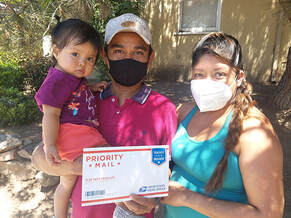 This article originally appeared in Stanford Social Innovation Review. Last year, when Governor Gavin Newsom appointed me California’s first senior advisor on social innovation to lead public-private partnerships, he already knew it was a moment for collaboration like never before. Although California had experienced decades of prosperity, not all Californians had benefited from the state’s success, and we needed to rethink our approach to build a California for all. In the face of the COVID-19 pandemic, business, philanthropic, and nonprofit organizations have partnered with government in unprecedented ways to support Californians. The state’s recently released Social Innovation Impact Report shows that under Governor Newsom’s leadership, our office has led public-partnerships totaling $3.9 billion in corporate and philanthropic funding, in coordination with $1.3 billion in public funding. We have created far more social impact than we would have by working alone. And while public-private partnerships are not new, California is the first state in the country to lead cross-sector collaborations at such a large scale. When the public, private, and philanthropic sectors partner, everyone benefits. In California, our partnerships are addressing problems including the state’s homelessness crisis, supporting California’s undocumented immigrants, and ensuring California families don’t go hungry. These partnerships are on the cutting edge of innovation, bringing new solutions to previously intractable problems, and providing models for other states and for the country. As President-Elect Joe Biden shapes his approach to governing—including how to provide both immediate and sustained public health and economic relief—there’s much to learn from California’s approach to partnerships. We’ve been bringing all hands on deck to address social challenges like supporting populations disproportionately affected by COVID-19, ending the pandemic, fighting for racial justice, and mitigating the impacts of climate change. Here are four important takeaways from our work over the past two years that may help other government teams—federal, state, or municipal—looking to lead through partnerships: 1. Partnerships provide a more expansive way of governing. As the first US state to have a senior advisor on social innovation embedded in the governor’s office, whose primary role is to coordinate policy priorities with the private sector, California is taking a cross-sector approach to effectively meeting people’s needs. We are collaborating between public and private sectors to broaden the impact of our work and bring different capabilities to the table. Our state’s COVID-19 Public Awareness Campaign provides a vivid example. In July, when public health experts were urging people to wear masks to slow the spread of the coronavirus, yet mask-wearing was still not widely adopted in many parts of the state, we began shaping a hard-hitting, surround-sound campaign to shift public behavior. Philanthropic partners like CDC Foundation, the Skoll Foundation, and Sierra Health Foundation provided funding in partnership with the California Department of Public Health, and together, we launched a statewide “Wear a Mask” campaign. Dozens of companies—including Facebook, Twitter, NBCUniversal, Comcast, and Ethnic Media Services—donated advertising space, and Google offered its behavioral health team to analyze data so that public health officials could better understand which messages were resonating. Sesame Workshop even pitched in by producing mask ads with Elmo, Oscar the Grouch, and Grover, aimed at kids going back to school. The campaign ultimately developed hundreds of assets in 10 languages. These have seen 485 million digital impressions, 1.4 billion television impressions, and 750 million radio impressions. This campaign was stronger, because we were working together with the private sector to maximize and amplify the message, and today California has one of the highest rates of mask adoption in the United States. 2. Partnerships produce innovative solutions. Public-private partnerships also bring new ideas to government and test them out in ways that government could scale. Sometimes, it can be difficult for government bodies to innovate, because policy leaders don’t want to take risks with tax-payer dollars. At the same time, smaller investments by just one philanthropy can’t have wide-spread reach. Philanthropic and corporate capital is precisely the type of flexible money that can help de-risk government spending. Take Project Homekey, an effort launched in June to convert hotels, motels, vacant apartment buildings, and other properties in need of rehabilitation into permanent, long-term housing for people experiencing or at risk of homelessness. We put out a request for proposals to local jurisdictions and dedicated more than $800 million to buying properties across the state. We also partnered with Blue Shield of California and Kaiser Permanente, who collectively contributed $45 million to support wraparound services like substance abuse counselors and job training programs where needed, and with Enterprise Community Partners, a national expert in affordable housing financing, to support the long-term financing of the properties. So far, the effort has created 6,055 units of permanent housing for those experiencing homelessness. But perhaps most important, the average per-unit cost is $138,512, including funding for services—a figure well below the average cost to build new housing units. This innovative approach to acquiring housing provides a model that government and the private sector alike could scale across the country. 3. Partnerships allow you to accelerate social change: While COVID-19 has revealed deep disparities in our society, such as communities of color being disproportionately affected, the gravity of the pandemic has also provided the opportunity to accelerate social change by taking bold risks through partnerships. Whether it’s supporting vulnerable Californians who have been left behind or providing housing or services to formerly incarcerated individuals, we are leveraging this moment of crisis as a catalyst for social change. This summer, in response to rising COVID-19 cases among incarcerated individuals and prison staff, the State of California expedited the release of Californians who were already on track to go home from California Department of Corrections and Rehabilitation (CDCR). Through our Returning Home Well initiative, which aims to break the cycle of recidivism, poverty, and homelessness in California, we worked to provide individuals with access to services proven to help formerly incarcerated people successfully reenter society. Alongside CDCR and the Department of Social Services, we partnered with Amity Foundation and Career Employment Opportunities to offer housing, health care, treatment, transportation, direct assistance, and employment support. With $15 million in public funding, and $15 million in philanthropic funding led by Meadow Fund, Chan Zuckerberg Initiative, Rosenberg Foundation, and more than a dozen other foundations, the initiative is now working with more than 100 community partners. So far, 6,171 individuals have received treatment services upon exit from CDCR institutions, and 2,011 individuals have received reentry housing, representing a 78 percent increase over last year. If successful, the program could influence the way we support systems-involved individuals going forward. 4. Partnerships have a multiplier effect. Partnerships can also provide a model for policy change that can be replicated in other jurisdictions. One example of a public-private partnership that’s providing a model for other cities and states is California’s Disaster Relief Assistance for Immigrants fund. When the federal government issued stimulus checks of up to $1,200 to each American in early 2020, it left out undocumented Americans—including immigrant Californians—who have been disproportionately performing essential jobs throughout the pandemic. In April, Governor Newsom announced an unprecedented $125 million disaster relief fund to fill this gap. Funded with $75 million from the state and an additional $50 million from 70-plus philanthropic partners and more than 800 individual donors (led by Grantmakers Concerned with Immigrants and Refugees), the fund has provided more than 230,000 undocumented Californians with one-time cash assistance of up to $1,000 per household to deal with specific needs of the COVID-19 pandemic. Thirty-two states and cities across the United States have already replicated the model so far. A How-To Guide for Public-Private Partnerships For any local, state or federal government seeking to adopt public-private partnerships as a new form of governance, or for philanthropic and private sector partners interested in thinking about how to best encourage such partnership, here are some lessons I’ve learned over the last year:
A lot of hard work lays ahead of us in California and across the country. As we have shown in California, we are stronger by working collectively. We hope these lessons from the last year of partnerships in our state can assist President-Elect Biden and leaders throughout the country in creating a world where all sectors work together to bring about change. 6/23/2020 0 Comments Why California’s spirit of community-led innovation will be key to our recovery This article originally appeared in CalMatters. After months of being confined to our homes, thousands of people have been shouting in the streets, risking their lives in the midst of a pandemic to fight structural racism and to be heard. It’s time to listen. When Gov. Gavin Newsom appointed me the first ever senior advisor on Social Innovation for the state of California one year ago, it was clear that my job wasn’t about bringing partners to the same old table in Sacramento. It was about building a new table entirely, one with room for all Californians. During my first eight months, I embarked on a border to border listening tour, visiting 80 organizations across 16 cities and convened with 750 nonprofit, philanthropic and business leaders. As a seventh generation Californian, I thought I understood the challenges we face. It turns out I had a lot to learn. What I discovered, and what we are all seeing unfold before our eyes, is that showing up matters. Listening matters. In California, equity isn’t just about demographics, it’s about geography. Innovation isn’t just about the tech titans of Silicon Valley or the entertainment moguls of Los Angeles, it exists in every community across this state. While each community is unique, every community is working creatively to address seemingly intractable problems, from homelessness to climate change. Government doesn’t have all the answers. Community-led social innovation must inform statewide policy. In the wake of COVID-19, emergency cash assistance programs like California’s Disaster Relief Fund for undocumented immigrants didn’t germinate in the head of a policymaker in Sacramento, they come from grassroots leaders who know first-hand how cash assistance can stabilize families during a crisis. Mayor Michael Tubbs’ universal basic income pilot, in partnership with the Economic Security Project, gave 125 Stockton residents $500 a month over the past year. They demonstrated that if you give low-income families an extra cushion, it can prevent the much more tragic – and expensive – problem of living on the streets. Armed with this evidence, Newsom is doubling down on the Earned Income Tax Credit to help California’s most vulnerable families get back on their feet. If we want to offset the devastating economic downturn and budget cuts, California also needs innovation that actually saves money. Last fall, I met Steve Wright, a surfer from Imperial Beach on the border between California and Mexico, where the Tijuana River dumps 60,000 cubic yards of sediment, 3,000 tires and thousands of empty plastic bottles into a California State Park. The state was spending $1.8 million annually to dispose of the garbage, so Wright started a cross-border job training program to clean up the trash and give people jobs at the same time. His organization, 4 Walls International, recently created a social impact bond that will save the state $7.5 million over six years, while paying back investors. Newsom also wants to ensure those who have traditionally been left out of our state’s economic prosperity, help lead the way to recovery. Judge Abby Abinanti, California’s first Native American female lawyer, is leading a model for justice reform by integrating Yurok cultural practices and healing into her Yurok Tribal Court, rehabilitating individuals who would be otherwise swept into the criminal-justice system. The Blue Lake Rancheria, located in rural Humboldt County, built a low-carbon community microgrid to help power government offices, businesses and a local Red Cross safety shelter, which helped save lives during the Public Safety Power Shutoffs, a model we can scale as we face the threat of wildfire season this year. The challenges we face as a state and nation are daunting. But even through the crisis, so many Californians are waking up every day committed to and calling for change. Equity will not be achieved through projects and policies alone, it is a lens through which we must see all of our work, and it should be the lens through which we see innovation as well. If we truly want to build a California for all centered on the spirit of innovation, we need to keep listening to all Californians and meet them on the road to recovery. 3/15/2020 0 Comments COVID19: What Philanthropy Can Do This article originally appeared on Medium. Ever since I started my role as Senior Advisor on Social Innovation to Governor Gavin Newsom, I’ve been saying this is a “moment for partnership like never before.” Never could I have imagined just how true that statement would become as it has in this moment. As the State of California embarks on the massive undertaking of slowing the spread of the COVID-19 pandemic in our State to save lives and help those already infected, we NEED our philanthropic partners like never before. Philanthropic capital is nimble capital. It can support innovation and outside- of-the-box community interventions alongside our statewide response. To those philanthropists considering how to meet the growing need, a few critical reminders: 1. This is a quickly evolving situation. Flexibility is more important than it’s ever been before. 2. This is a marathon not a sprint. By all accounts COVID-19 will get worse before it gets better. As immediate needs continue to surge, we also need to be investing with a long-term focus in mind. 3. There are many ways to support our efforts, and we need all of them! My goal in presenting a buffet of opportunities for partnership is not to be prescriptive, but to open up new lines of communication and thinking about how to partner. Invest where you are uniquely positioned to do so, and bring all of your resources, regional understanding, and relationships to bear. With that in mind, there are two primary categories of need that are emerging: first supporting the public health response and second supporting vulnerable communities. SUPPORT THE PUBLIC HEALTH RESPONSE A few areas where there are opportunities for partnership on the public health response include what I’m calling the 4 Ts — testing, tracking, treatment, and transparency: 1. Testing: We know that increasing testing capacity has been a challenge. With private lab testing starting in California this week, our capacity is much more significant, but we still need to ramp up to meet the growing need. Investing in testing innovation is an important role that philanthropy can play. Private researchers like Stanford and UCSF have developed in-house tests that they are using, and the Gates Foundation has developed home testing kits that they are processing through the University of Washington. And just today the California Governor’s Office announced a partnership with Verily to develop community testing sites using their Project Baseline technology. This kind of innovation is exactly what we need. 2. Technology + Tracking the Spread of the Disease: We have in-house predictive models at California’s Department of Health and Human Services that can show the spread of the virus across California, but we also know that we have the best technology in the world right here in our state. Governor Newsom is committed to leveraging external AI partners to try to predict the spread of the COVID-19 across California so we can be prepared with our response. 3. Treatment: There is currently no known vaccine for COVID-19. As a state, we will be relying on private research institutions to support vaccine testing and therapeutic treatment research, so investing in private research is another way to support the public health response, especially for the long-term. 4. Transparency through Active Communications: Finally, as we move from the containment phase to the mitigation phase, we will need strong messaging to ensure all Californians have the correct information to stay safe. We are working on a statewide PSA Campaign that will launch soon, and have already had so many private partners lend their support to that effort. But local communities — especially local departments of public health — are each going to need support to develop local messaging. Remember, we are a state with 58 counties, each of which will experience this outbreak in a different way, so supporting local jurisdictions will be key. Organizations like the CDC Foundation are playing a critical role in supporting local communications strategies. SUPPORT VULNERABLE COMMUNITIES The second area where we’re seeing a huge need for philanthropic partnership is supporting California’s already vulnerable and disadvantaged communities. Low wage workers, low-income families, homeless individuals, and other underserved populations are going to be disproportionately affected by this pandemic. How can you help support those most vulnerable to the spread of COVID-19? 1. Use community foundations. As this virus is poised to spread throughout the state, community foundations are going to be in the best position to support hyper-local relief efforts in a way that the State cannot. Philanthropy California, a statewide coalition of grantmakers, is working closely with the League of California Community Foundations, United Ways and others to set up regional disaster funds throughout the state. This will be critical to help us get resources to communities that don’t have as much access to philanthropic funding (like inland California and tribal areas). 2. Support local nonprofits serving vulnerable populations — food banks (especially if kids can no longer get school lunches), meals on wheels, senior centers, homeless-serving organizations — are also relying on philanthropic support to get through this outbreak. Nonprofits themselves are going to be particularly vulnerable given the increase in demand, and the decrease in funding with canceled fundraisers and the stock market decline. And of course flexible, general operating support is critical during this uncertain time — both making new unrestricted grants and freeing up prior programmatic grants to convert to general operating support are desperately needed. 3. Support organizations that provide individual assistance. 57% of Americans don’t have $500 in their bank accounts to cover an emergency. The State has many benefits that will be available to individuals — paid family leave, unemployment insurance, etc. — but some of our most vulnerable Californians won’t be eligible for those (i.e. non-workers), and often flexible cash grants to cover rental payments or utility bills will be needed most. I encourage you to look for structures that are already in place like flexible rent subsidy pools or community foundations, that are set up for individual assistance. The Hilton Foundation, for example, just made a $250K grant to Brilliant Corners to support rental subsidies in Los Angeles County. 4. Finally, support small businesses. 90% of businesses fail within two years of being struck by disaster. SBA loans are available to business owners, and just last week San Francisco announced a million-dollar fund to support $10K grants to small businesses. The Governor’s Office of Business and Economic Development is working to set up 0% loan funds through CDFI’s, which are a great place to invest. We are also working to set up a statewide philanthropic fund for small businesses — stay tuned for more information on that soon. I’ll end just as I started: This is a moment for partnership like we’ve never experienced before. First, it’s a moment for partnership with the state: we are executing on addressing an unprecedented pandemic here in California, and we need your partnership to support local communities who are going to experience this global pandemic in different, locally unique ways that have hyper-local needs. It’s also a moment for collaboration with each other — scattershot grantmaking is not going to be as impactful as donors coming together to amplify their impact by working together. Use this as an opportunity to work through intermediaries, like the CDC Foundation or Philanthropy California, and for collaborative grantmaking. Together, our work will go so much farther — the sum is greater than its parts. Governor Newsom is committed to working in partnership with the private and philanthropic sectors to address the COVID-19 virus head on, slowing the spread and saving lives! We hope you will join us as we meet this moment head-on. STATE ECONOMY MAY BE THRIVING, BUT NOT ALL CALIFORNIANS ARE SHARING IN THAT PROSPERITY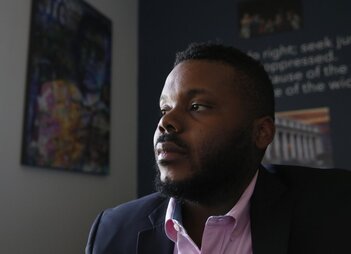 This article by Mayor Michael D. Tubbs and Kathleen Kelly Janus originally appeared in The Mercury News. California’s economy is thriving, but not all Californians are sharing in that prosperity. Inland California, which stretches from Sacramento to Stockton through Fresno, Bakersfield, and the Inland Empire, contributes 17 percent of California’s economic output – but faces more than its fair share of poverty, unemployment and opportunity gaps. Philanthropic giving mirrors those trends. California’s Bay Area has 20% of the state’s population and receives 53% of its philanthropic dollars, while the San Joaquin Valley is home to 11% of the state’s population and receives just 3% of its nonprofit dollars. Similarly, the Inland Empire accounts for 11% of California’s population but receives just 1% of the state’s nonprofit dollars. If you’re a philanthropist investing in housing for the 59,000 people on our Los Angeles streets or services for the homeless in San Francisco, you might be wondering what these problems have to do with you. The answer is, everything. The fates of our communities are intertwined. As people migrate inland in pursuit of more affordable living, philanthropy must recognize the opportunity to truly build a California for all. Bay Area organizations like Hamilton Families, are rehousing homeless families as far away as Sacramento and Fresno to address the skyrocketing need. We must ensure that jobs, supportive services, and affordable housing follow. If we don’t, we are just busing people out and passing big problems down the road, instead of building communities of choice where people can thrive. In this spirit, Gov. Gavin Newsom is leading a “Regions Rise Together” initiative to support economic development, land use, and transportation in communities that have been left behind. Some influential investors are already redefining the philanthropic landscape. Philanthropy California has guided grant-making organizations across the state toward funding opportunities in San Joaquin Valley and the Inland Empire. The James Irvine Foundation and The California Endowment are increasing nonprofit capacity throughout the Central Valley and Salinas. Philanthropy is critical to catalyze government dollars. The city of Stockton leveraged The Spiegel Family Foundation’s $20 million donation to launch Stockton Scholars, double the number of counselors in Stockton Unified School District and align its graduation requirements with the CSU/UC system. This catalytic investment triggered a $2 million commitment in the state’s 2019 budget to produce a feasibility study for a Cal State University in Stockton, which would create more than 2,000 local jobs and generate more than $250 million to Stockton’s local economy. Philanthropic investments also help test new ideas. With support from the Economic Security Project, Stockton launched SEED, the nation’s first mayor-led guaranteed income pilot. In February, SEED began giving 125 low-income residents $500 a month for 18 months. This partnership helped transform universal basic income from a fringe idea to a viable policy solution that could help lift people out of poverty throughout our state. Environmentalists also need to look Inland. Forty percent of emissions in our state are from vehicles. With lack of affordable housing “super-commuters,” those traveling 90 minutes or more to work every day, are on the rise. We must marshal every available resource – from state climate resilience programs to directing social capital into new businesses, green infrastructure, and housing through Opportunity Zones — if we want to create local jobs and healthier outcomes. Californians must start thinking beyond their own backyard. Philanthropy’s nimble capital, local government’s knowledge, and the nonprofit sector’s trust must be deployed together to empower those who have been left behind. If we continue to operate in silos, the gaps between us will continue to grow. If we work together, all Californians can rise. 6/22/2019 0 Comments California faces multiple crises. Can we solve them without help from philanthropy?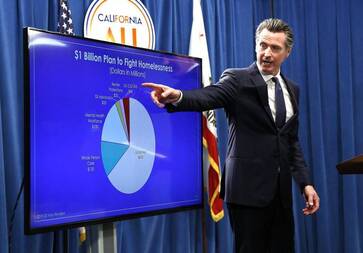 This article originally appeared in the Sacramento Bee. California is no stranger to crisis. Nearly 20 years ago, when we were experiencing rolling blackouts across the state and the fallout after the dotcom bubble burst, the governor invited nonprofits and philanthropists to join him in solving the most pressing social problems of the day. But philanthropy was wary of getting too close to government, and government quickly became too distracted with the energy crisis to cultivate meaningful partnerships with philanthropy. Today, skyrocketing housing costs are forcing Californians out of their communities and onto the streets, our education system ranks among the lowest in the nation and more than a million Californians don’t have clean drinking water. We are in the middle of a mess in our state. But, today, the sector has changed. We are finally willing to admit that we need each other. California is the land of innovation. But that innovation does not need to be confined to the tech giants of Silicon Valley, the biotech labs of San Diego or the entertainment masterminds of Los Angeles. We have the opportunity to marry California’s innovative spirit with state government and, in doing so, help solve many of our greatest and most pressing social issues. In fact, many of our greatest innovators are hard at work in local communities solving the most pressing social problems we face. In October of 2017, when the fires ravaged Sonoma County, leaving hundreds of people without homes, La Luz Center in Sonoma didn’t just rebuild housing. They saw it as an opportunity to train low-income workers in the construction trade. In the Bay Area, Doniece Sandoval, the founder of Lava Mae, developed a network of mobile showers for the homeless, using “radical hospitality” to give their guests dignity, a first step in rebuilding their lives. And in Stockton, Mayor Michel Tubbs guaranteed 100 low-income residents $500 a month to see if a system of universal basic income might alleviate some of the daily shocks of living in poverty. People are coming together across sectors like never before to address long-standing problems. In a recent census convening in Sacramento coordinated by Philanthropy California – a statewide collaboration of grantmakers – every square inch of the room was packed with community leaders, philanthropists and government officials. It was so crowded that people were literally sitting on the floor, taking notes. Together, they are devising a shared strategy to count every Californian in the 2020 census and avoid the billions of dollars in lost federal funding as a result of undercounting in the past. In Los Angeles, the California Community Foundation is pulling from its endowment and partnering with foundations, developers and lenders to help ensure LA County is successful in its commitment to more than triple the production of affordable housing and support services to keep low-income populations housed. Gov. Gavin Newsom has once again invited philanthropists, social entrepreneurs and CEOs to be part of his agenda for change in California, and this time the response has been overwhelming. As I step into the first-ever role as senior adviser on social innovation for Newsom, I am committed to elevating stories of social change from every community and building strong multi-sector partnerships across our state. Private philanthropy is nimble enough to invest in research and development, while government has the unique power to purchase and scale new solutions. And of course none of that matters without strong nonprofits on the ground who are implementing services, welcoming clients through their doors and being responsive to their lived experiences. In order for us to move through the crisis we’re seeing in California, we have to ensure that we are not only investing in service to our communities but acting as a unified driver of growth, change and justice for all.  This article appeared in Stanford Social Innovation Review. Over the past several months, philanthropy has faced rising criticism for its lack of transparency or accountability, perpetuation of wealth inequality, and preservation of a system of exploitation. As Ford Foundation CEO Darren Walker reminds us, this critique is not new: Decades ago, Martin Luther King Jr. warned philanthropists not to “overlook the circumstances of economic injustice which make philanthropy necessary.” One way in which these injustices have played out is in philanthropy’s failure to hire or fund people of color. Less than 5 percent of foundation CEOs are diverse leaders, and just 4 percent of grants and contributions go to diverse-led organizations. These bleak statistics have many leaders—including ourselves—trying to do better. To find our way forward, we’ve convened dozens of funders over the past year to discuss how to improve our efforts around diversity, equity, and inclusion (DEI). Three guidelines have emerged: 1. Re-define Risk “Grassroots doesn’t mean small, grassroots can be big and impactful.” –Solome Lemma, Thousand Currents Funders often label funding applicants as risky because they lack data to show their impact or don't have a degree from certain universities. Such an assessment fails in a major way: It doesn't incorporate the value of a leader’s ties to the communities they serve and experience in the field. Philanthropy must acknowledge the extent to which bias and racism play a role in this risk calculation and create metrics that value experience and community connections. This has nothing to do with a so-called “lowering of the bar.” It's about valuing leaders from all backgrounds and their hard-won experience. For example, Segal Family Foundation launched its African Visionary Fellowship in 2017 to give weight to experiential capital in its portfolio and find ways to propel African leaders toward resources at the same rate as their Western peers. Similarly, Thousand Currents seeks to fund grassroots organizations in the countries where they work, combatting the trend that only 12 percent of international organizationsthat receive funding are actually operating in the developing world. 2. Emphasize Trust “Philanthropists must shift from gatekeepers to allies.” –Katie Bunten-Wamaru, formerly of Segal Family Foundation Trust is a key ingredient to building processes that favor diversity, equity and inclusion. Yet lengthy grant applications and extensive reporting requirements for nonprofits imply a lack of trust. They also disproportionately affect diverse leaders, who may lack connections or face a double standard due to implicit biases. Philanthropy must shift from the position of gatekeeper to the role of ally and partner. The Whitman Institute, for instance, employs “trust-based philanthropy,” a movement which seeks to address the power imbalance between funders and grantees by eliminating grant applications, reducing reporting requirements, and providing multi-year grants so that nonprofits don’t have to worry about losing funding if they are honest about both their successes and their failures. In another example, Heinz Endowments used grantmaking to get not just input from the community, but also engagement from community leaders to form strategic priorities for key areas of its philanthropy. Both organizations put those that they are serving—either grantee partners or the community—at the center of their approach, moving forward from a place of trust. 3. Reflect the Community While there has been a push for nonprofits to be more transparent about their staff, philanthropy has remained mostly silent about the diversity of its teams and portfolios. According to D5 Coalition, 80 percent of foundation staff and 91 percent of foundation CEOs are white. Such uniformity goes a long way toward explaining inequitable funding outcomes; after all, staff, CEOs, and others with decision-making authority play a critical role in any changes to an organization. Foundations are already pushing themselves to reflect the communities they serve in a number of ways. The Rosenberg Foundation has an advisory committee of dozens of community-based leaders who help find underrepresented talent for the Leading Edge fellowship. And Tipping Point Community audited its staff and board, and surveyed its grantees, to discover ways that it could augment DEI in its work environment, staff, and grantmaking. We have reached a moment when foundations must face the ways they may be reinforcing inequality. By re-defining risk, emphasizing trust, and reflecting the community, philanthropy can make great progress on diversity, equity and inclusion. Failing to do so may perpetuate the very inequities foundations seek to solve. |
|
 RSS Feed
RSS Feed